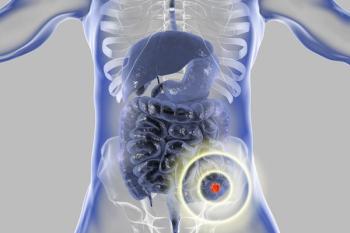
Key Takeaways: ctDNA Assays For Patients With CRC Undergoing Resection of Metastases
Drs Liliana Bustamante and Richard Kim explore conclusions highlighted by a paper on postoperative MRD analysis as a strong prognostic biomarker in colorectal cancer.
Episodes in this series

Richard Kim, MD: Hello and welcome to the discussion portion of Between the Lines, a journal club experience. We just reviewed the article detection of molecular residual disease using personalized circulating tumor DNA Assays in patients with colorectal cancers undergoing resection of metastases.
So Dr. Bustamante, I think as we discuss sort of the highlights of the paper, what are some of the key takeaways from this paper, from your perspective?
Liliana Bustamante, MD: I think from my perspective a few things. First off, circulating tumor DNA has great sensitivity and specificity for detecting or predicting patients’ progression, especially when it's done over two time points, postoperatively and then at a different time point. That certainly increases sensitivity and specificity above all the tests that we currently have available. And it gives us the ability of identifying patients that will progress radiographically a few months ahead, which will make a difference in what we do to follow them or to treat them when this test becomes positive. It's the only thing that had a significant, a statistically significant association with disease free survival, as we mentioned before. I think that's a great takeaway as well. I think this is going to have nice implications for our practice.
Richard Kim, MD: I think I agree with you. And I think, the circulating tumor DNA, as you know, is currently approved for stage two and stage three disease more as a prognosis marker. So obviously this article does not deal with stage two and three, but more of a stage four disease who are what we call no evidence of disease. After surgical resections, everything is gone, but the question is, what are the risks of those tumor recurrence. And I think, addition of this tumor DNA is definitely based on this paper is a prognostic indicator that it will predict- it's prognostic in terms of who will do- who will have a worse disease-free survival and who will have a worse overall survival. Now I think moving in the future, I think whether this biomarker could be predictive or not, will be another question. I think that the dilemma that Dr. Bustamante, you and I will be facing is if after surgery, if the tumor DNA, circulating tumor is positive, then what do we do at that time. Do we give chemo understanding that there is no radiographic finding, no radiographic evidence of disease? If you do give chemo, how long do you give it to- how long do you give it for, three months, six months, or do you give it until tumor DNA goes away. Or what happens if tumor DNA never goes away. I think those are the, some of the clinical questions that we have that, we don't have answer to. But clearly as I- as you mentioned, this is a prognostic biomarker that we can use in conjunction with the radiographic imaging and also CEA as well, to sort of help better guide patients in terms of what to do after surgery.
Liliana Bustamante, MD: And I think unfortunately we already have that dilemma. These patients are diagnosed with stage four and quote unquote incurable from the beginning. And then later on we say, hey, listen, you don't have a lot of metastases, let's try to get you to no evidence of disease, which is kind of what every patient with cancer desires. But I think specifically when this test is negative, at least on two standpoints, I think it will give us a lot of reassurance that more therapy is not needed. We're not creating toxicities that come from therapy. I think you're exactly right, that we don't know what we will have to do clinically for patients that are positive without radiographic disease. Maybe, do we follow them closer, do we do different things, different types of testing so that when they do become positive, we act. But I think having this data is going to also help maybe incorporate this in future clinical trials, when we're evaluating the need for chemotherapy or the need for adjuvant therapy post-surgery, using ctDNA and correlating that with what we do with whatever intervention we're testing is going to also help us interpret this better.
Transcript edited for clarity.
Newsletter
Stay up to date on recent advances in the multidisciplinary approach to cancer.




















































































